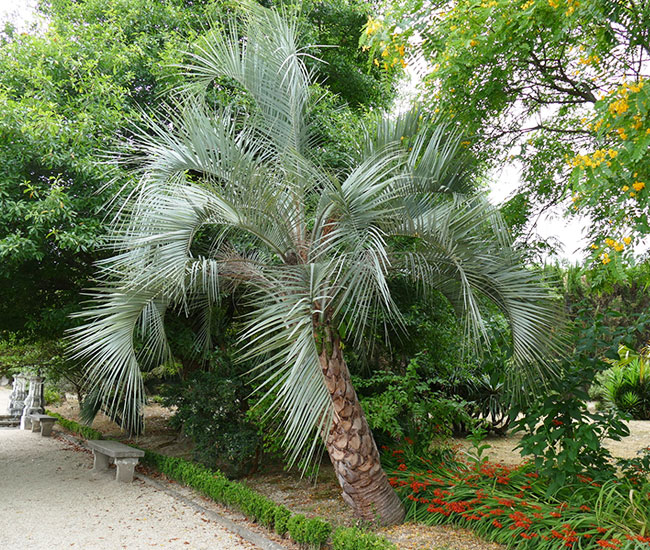
The Pindo Palm Tree, scientifically known as Butia capitata or Butia odorata, is a highly regarded palm worldwide due to its captivating appearance, cold tolerance, and the bright yellow fruit it bears, which can be used to make jelly.
This palm is native to South America, specifically the southern regions of Brazil, Uruguay, and Argentina.
Its elegant crown adorned with blue-green fronds makes it a superb choice for pool-side landscaping and container planting. This low-maintenance palm is particularly popular among homeowners because of its versatility.
Buy Pindo Palm Tree On Amazon »
Quick Facts:
| Scientific name: | Butia capitata or Butia odorata |
| Common names: | Pindo Palm, Jelly Palm, Wine Palm. |
| Origin: | Native to Brazil, Uruguay, and Argentina. |
| Growth Rate: | Slow. Up to 15 ft and 10 ft wide. |
| Cold Tolerance: | USDA Zones 8a (10 – 15 F) to 10b (35 – 40 F) |
| Light Req: | Partial shade to Full sun. |
| Water Req: | Low. |
| Soil Req: | Widely adaptable. |
| Fruit: | Yes. Yellow to orange. Edible. |
| Propagation: | By seed, germinating in 6 months. |
Pindo Palm Appearance
Butia capitata can gradually attain heights of 10-20 feet and widths of 10-15 feet, although it typically remains under 15 feet in height and spreads to about 10 feet.
The robust gray trunk is enveloped in old leaf bases and reaches a height of approximately 15 feet with a diameter of 1-1.5 feet. On occasion, you may encounter specimens with a clean, unadorned trunk.
Lacking a crownshaft, this palm exhibits beautiful arching leaves that emerge directly from the trunk. These pinnate, or feather-like, leaves vary in color from green to bluish-gray and measure approximately 5-10 feet in length.
Each leaf comprises 80-150 leaflets that stretch to around 20-26 inches in length. They are supported by 3-4 foot-long petioles adorned with spines along both edges.
Pindo Palm Flowers and Fruits
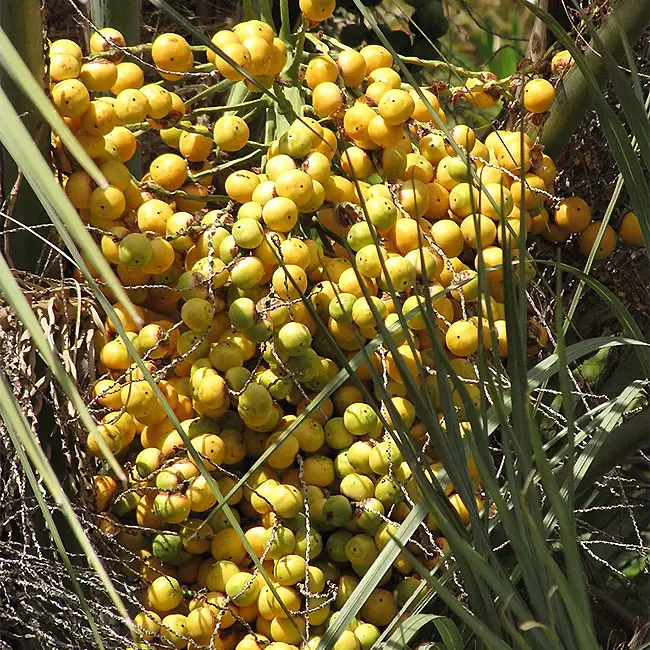
Towards the end of spring, the Pindo Palm produces small yellow to orange-red flowers in clusters on large, 3-4 foot-long inflorescences. These flowers are monoecious, meaning individual flowers can be either male or female, but both sexes can be found on the same plant. They are typically pollinated by insects and wind.
Following the flowering period, the tree bears bright orange fruits, often referred to as “pindo dates,” in large clusters. These dates are round to oval-shaped, juicy, and edible, with a diameter of approximately 1 inch. They reach maturity in the summer.
The fruits are versatile and can be consumed fresh, pureed, or used to create delicious jams and wine. They are also a key ingredient in making jelly, hence the nickname “Jelly Palm.” However, it’s worth noting that ripe fruits falling to the ground can create quite a mess.
How to Care for Pindo Palm
The Pindo Palm exhibits resilience to saltwater, drought, and various weather stresses once it has matured. This low-maintenance palm is not particularly demanding when it comes to soil type, as long as it offers adequate drainage.
It thrives best when exposed to full sun or partial shade and has no specific nutrient requirements. Additionally, it requires minimal pruning, making it an attractive option for landscape enthusiasts.
Light
This plant thrives in full sun, although it can tolerate partial shade. Planting it in a heavily shaded area may result in a slower growth rate. For optimal performance, it is advisable to plant it as a stand-alone specimen with ample space around it.
If you intend to grow it indoors, ensure you place it in a well-lit area with abundant sunlight. During the warm months, consider moving it outside to provide it with additional light.
Soil
This plant is not particular about soil type and can thrive in both clay and sandy soils as long as they offer good drainage. While soil amendment is not a necessity when planting this palm, adding high-quality topsoil to the planting hole can be beneficial.
It’s essential to assess the drainage of the soil, as poor drainage can lead to root rot issues. Ensure that the soil drains effectively before planting the palm.
Watering
During the initial two years of establishment, this palm requires regular watering. However, once established, it only requires occasional to moderate watering.
As the pindo palm possesses drought tolerance, it’s advisable to allow the soil to dry between watering sessions to prevent soggy soil, which can lead to trunk and root rot.
Monitor soil moisture using a soil probe, moisture meter, or your fingers. Water the palm when the top 3 inches of soil feel dry. For deep watering, employ a slow-drip method to ensure thorough saturation of the soil.
The water should penetrate the soil to a depth of approximately 2 feet and cover an area of about 4 feet around the base of the trunk.
Fertilizing
Regarding fertilization, the frequency depends on your soil type. To prevent nutritional deficiencies, it is recommended to apply a high-quality palm fertilizer with a continuous release formula twice a year during the growing season.
Based on our findings, fertilizers with a balanced ratio of 15-5-15 or 10-5-10, where the Nitrogen and Potassium levels are equal, tend to yield the best results.
Temperature
The Pindo palm is the most cold-tolerant palm with feather-shaped leaves currently in cultivation. It thrives in USDA Zones 8a (10 – 15 F) to 10b (35 – 40 F).
Mature Pindo palms can endure temperatures as low as 5F with some leaf damage occurring around 15F. At approximately 10F or lower, the leaves are typically lost.
Remarkably, some Pindo palms have been known to survive harsh winters with temperatures plummeting to 0F, although they were heavily mulched and provided minimal cold protection. It’s quite impressive how a palm tree can not only survive but also recover quickly after enduring such stress.
If you intend to grow this palm outside of zone 8, you’ll need to create a microclimate and provide substantial winter protection, such as wrapping and leaf piles.
Keep in mind that it may not look as stunning if it has to shed all its foliage every year, but this is a compromise many palm enthusiasts make to cultivate it in cooler climates.
Pruning
Maintaining a neat appearance for the Pindo palm requires minimal pruning. Simply remove dead, loose, or broken fronds. Avoid trimming healthy, green fronds as they are essential for the palm’s nutrient uptake.
If you find it necessary to remove healthy fronds for aesthetic reasons, limit your pruning to those that grow below the horizontal plane of the crown.
Avoid the so-called “hurricane cut,” a practice some homeowners employ in preparation for hurricanes, as it harms the palm and deprives it of essential nutrients.
Common Pests/Diseases
Generally, the Pindo Palm is a low-maintenance plant that typically does not cause many issues. Occasional problems for the Pindo Palm include palm leaf skeletonizer, scale insects, and micronutrient deficiencies.
Fortunately, there are no major diseases that you need to worry about. Keep in mind that it can develop root rot if the soil remains excessively moist and poorly drained.
Propagating
The propagation of the Pindo palm is primarily done through seeds, but it’s worth noting that this process is exceedingly slow. Germination can take several months, and it takes even longer for the plant to reach maturity. Therefore, it’s often more practical to acquire a three-year-old plant from a nursery.
Landscaping With Pindo Palm
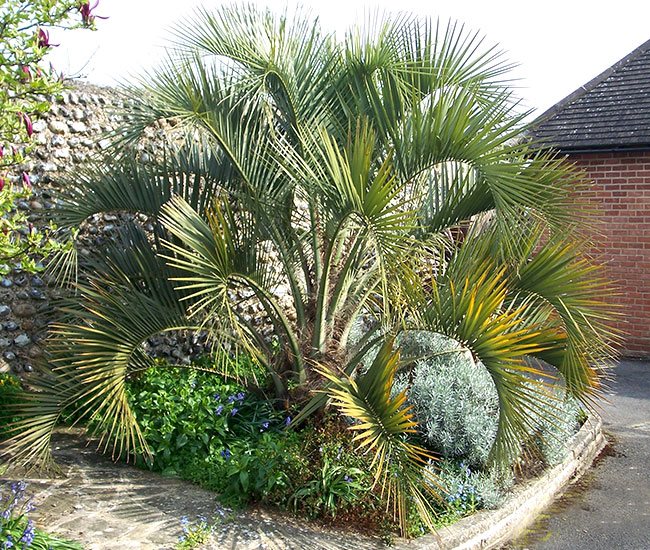
Whether you choose to plant just one or several, the Pindo palm can steal the show in your landscape design. It looks equally impressive as a standalone specimen or as the central focus in a planter.
If you’re considering placing it near a fence or a house, be sure to leave approximately 7 feet of space for future growth. When planting in a row, provide about 10 feet of separation between the palms, allowing each plant ample space to thrive. In my opinion, they don’t look as appealing when planted closely together in clusters.
This remarkable palm is well-suited for various landscaping scenarios, such as a focal point for a circular driveway or yard, lining along a walkway, anchoring a large tropical bed, serving as an accent at the corner of a building, or framing the entrance to an impressive driveway.
Keep in mind that the falling fruit can create a mess, so it’s advisable to plant it at least 10 feet away from the pool, patio, or decks.
Growing Pindo Palm Indoors
You might be wondering if the Pindo palm can thrive in a container indoors. The answer is yes, it can. In fact, the Pindo palm makes an excellent houseplant due to its slow growth rate, adaptability to a wide range of soils, and drought tolerance.
To successfully cultivate a Pindo palm indoors, you’ll need to provide it with sufficient light, proper watering, good drainage, and occasional fertilization.
Sun-loving palms may struggle to receive the necessary amount of sunlight indoors, so it’s essential to place the plant in a well-lit area near a window with abundant sunlight.
Avoid positioning the pot directly under vents to shield it from dry air. I recommend watering it with filtered or distilled water to prevent chemical and salt buildup.
Additionally, consider repotting it every three years to refresh the soil, even if you’re using the same pot.
Other Butia Varieties
Butia capitata is native to Brazil, Argentina, and Uruguay, where it readily hybridizes with other members of the genus, as well as palms from other genera. For instance, Butia yatay exhibits similarities in cold hardiness and appearance but features leaves that spread more widely.
Another highly cold-hardy species is Butia eriospatha, characterized by shorter, bright green leaves and leaf bases adorned with brown hair.
There’s also a hybrid between the Pindo Palm and Queen Palm (Syagrus romanzoffiana) known as Butiagrus nabonnandii or Mule Palm, which also boasts cold tolerance.
Frequently Asked Questions
In this section, I want to answer some of the most popular questions I get about this plant.
How Fast Do Pindo Palms Grow?
The growth rate of Pindo palms typically ranges from 12 to 24 inches per year, contingent on the prevailing growing conditions.
This pace is considerably slow when considering the ultimate size of approximately 15 feet in height and a 10-foot wide spread that mature Pindo palms attain.
If cultivated in a container, their growth is even more sluggish, averaging around 10 to 15 inches per year, eventually reaching a height of 5 to 7 feet. Remarkably, these plants can live up to 80 years.
Are Pindo Palm Fruits Poisonous to Dogs?
No, they are not. Pindo palms produce edible fruits that are safe for consumption by both humans and dogs in their raw form. These fruits are non-toxic to dogs, although it’s possible that both dogs and some individuals may experience an upset stomach after consumption.
Nevertheless, they are not considered toxic, and it is entirely safe for dogs to consume fallen jelly palm fruits from the ground.
Pindo Palm Pictures
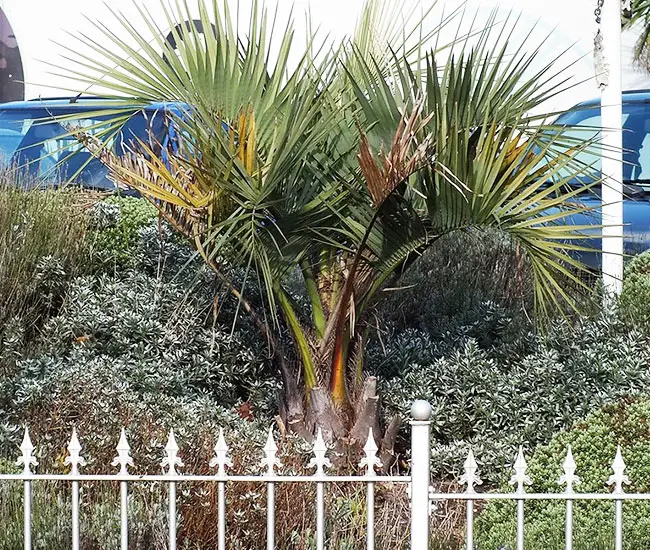
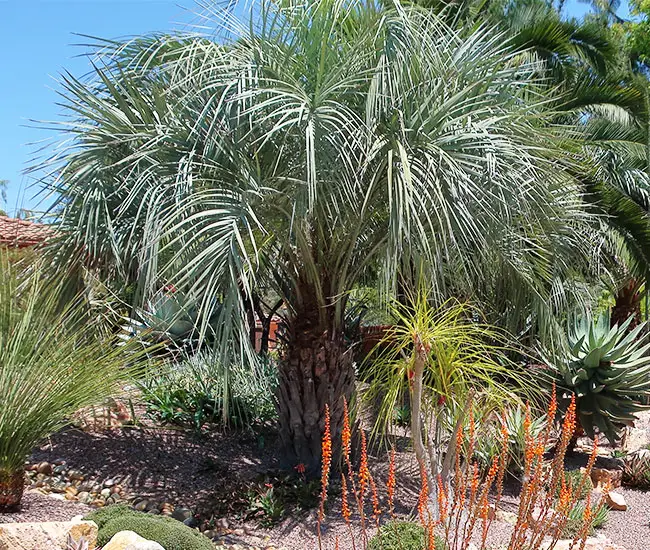
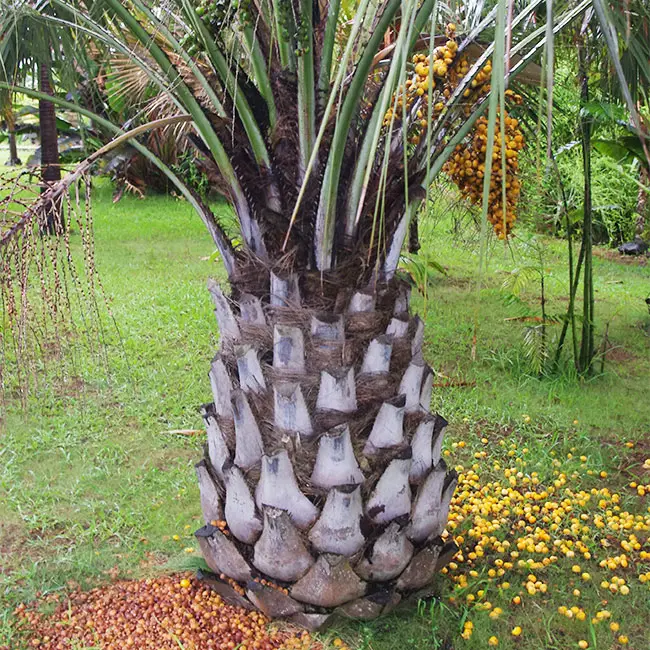
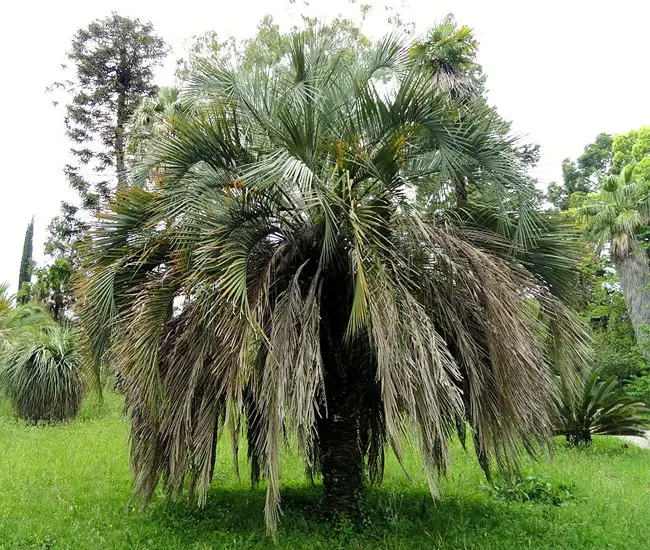
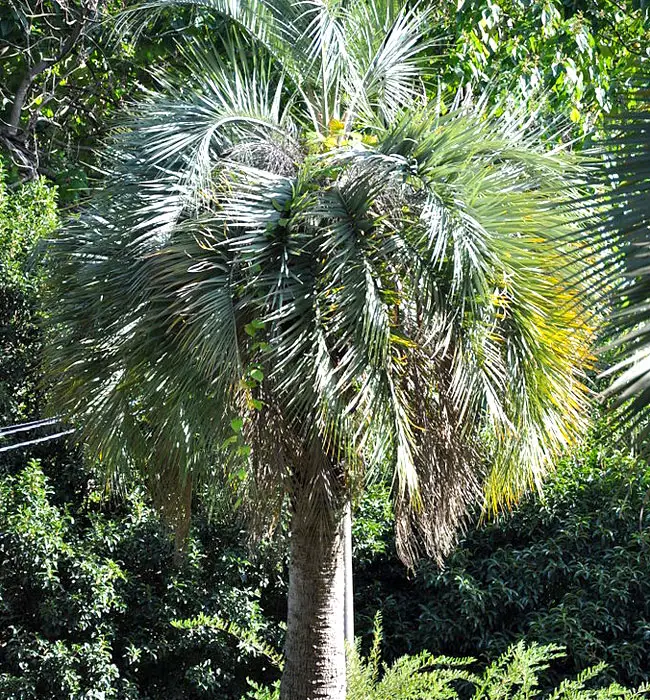
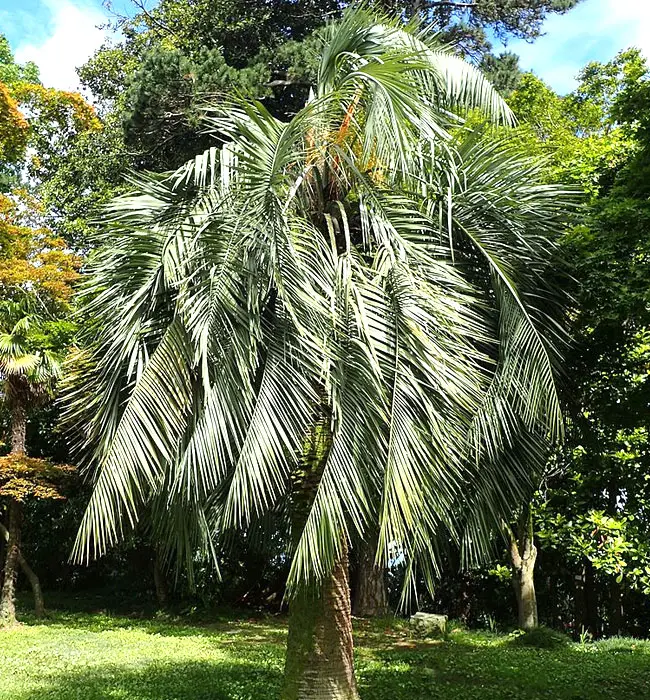
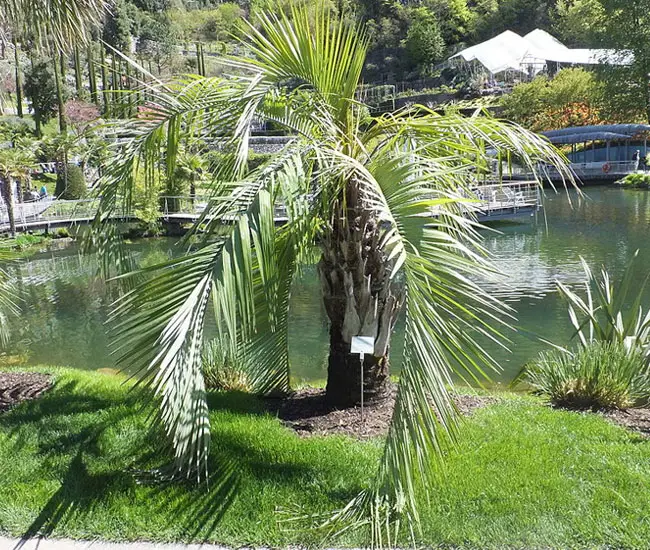
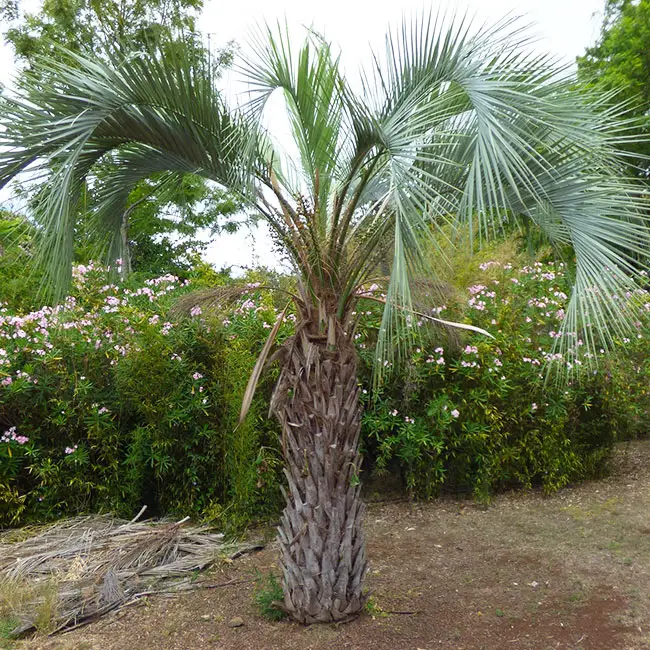
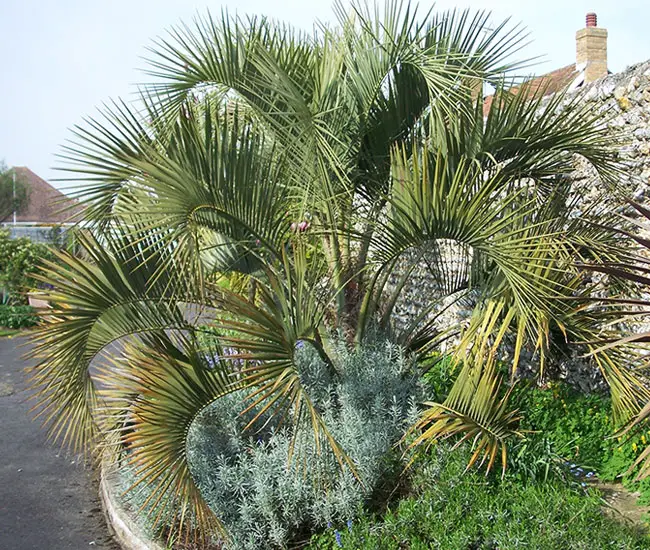
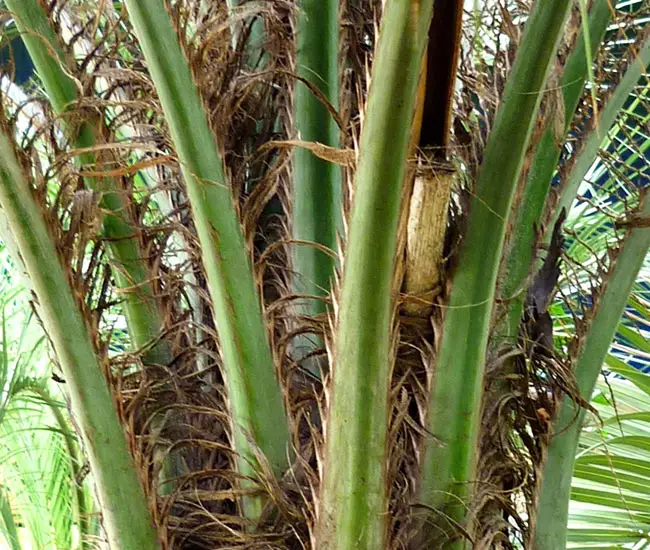
More information can be found on EDIS and Floridata sites.
Buy Pindo Palm Tree On Amazon »

Do you have pindo palms in 5-10 gal. size and do you deliver and plant?
Is it too hot in Arizona for one of these?